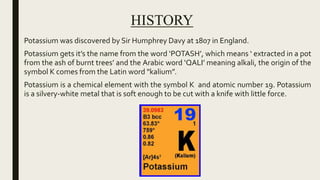Potassium
- 1. POTASSIUM SUBMITTED BY:- TANVIAGGARWAL M.SC FOODSAND NUTRITION 2ND SEM
- 2. HISTORY Potassium was discovered by Sir Humphrey Davy at 1807 in England. Potassium gets it’s the name from the word ‘POTASH’, which means ‘ extracted in a pot from the ash of burnt trees’ and the Arabic word ‘QALI’ meaning alkali, the origin of the symbol K comes from the Latin word "kalium”. Potassium is a chemical element with the symbol K and atomic number 19. Potassium is a silvery-white metal that is soft enough to be cut with a knife with little force.
- 3. SOURCES Leafy green vegetables such as spinach, parsley, and lettuce, as well as broccoli, peas, lima beans, tomatoes, and potatoes, especially the skins, all have significant levels of potassium. Fruits that contain this mineral include oranges and other citrus fruits, bananas, apples, avocados, raisins, and apricots, particularly dried. Whole grains, wheat germ, seeds, and nuts are high-potassium foods. Fish such as flounder, salmon, sardines, and cod are rich in potassium, and many meat foods contain even more potassium than sodium, although they often have additional sodium added as salt. Potassium may also be obtained from the following herbs: red clover, sage, catnip, hops, horsetail, nettle, plantain and skullcap.
- 4. ABSORPTION Absorption occurs as a nutrient passes through the walls of the intestine into the bloodstream or lymphatic system. Absorption may be considered to be active or passive, the former type of absorption requires energy to occur, while the latter form does not. Potassium absorption occurs in the portions of the intestine called the ileum and the jejunum -- the final two of three sections in the small intestine -- and it is a passive process, which means that potassium diffuses into your body on its own
- 5. TRANSPORT Since the cell membrane is impenetrable for potassium ions, it has to be Trans located through specific membrane transport proteins. To attain intracellular concentrations beyond this, potassium is transported into the cell actively through potassium pumps, with energy being consumed in the form ofATP. UTILIZATION Potassium is one of the most important minerals in the body. It helps regulate fluid balance, muscle contractions and nerve signals. What's more, a high-potassium diet may help reduce blood pressure and water retention, protect against stroke and prevent osteoporosis and kidney stones.
- 6. STORAGE Most of the body's potassium is located inside the cells. Potassium is necessary for the normal functioning of cells, nerves, and muscles. The body can use the large reservoir of potassium stored within cells to help maintain a constant level of potassium in blood. Potassium is mainly stored in the body cells , including those of bones.However, the body only retains the amount needed to function properly at the moment. The body doesn’t deposit potassium, as it does glucose, for future use. Instead, healthy kidneys flush out excess potassium, excreting it in urine.
- 7. EXCREATION Potassium is excreted primarily in the urine, some is excreted in the stool, and a very small amount is lost in sweat. The kidneys control potassium excretion in response to changes in dietary intakes, and potassium excretion increases rapidly in healthy people after potassium consumption, unless body stores are depleted. The kidneys can adapt to variable potassium intakes in healthy individuals, but a minimum of 5 mmol (about 195 mg) potassium is excreted daily in urine. This, combined with other obligatory losses, suggests that potassium balance cannot be achieved with intakes less than about 400–800 mg/day.
- 8. BIO-AVAILABILTY Potassium is found in most plant and animal tissues, with fruits and vegetables having a higher nutrient density than cereals and animal foods. Potassium is intrinsically soluble and quickly dispersed in the luminal water of the upper digestive tract. Little is known about the bioavailability of potassium, with the majority of work being centred on the assessment of urinary potassium losses after potassium salt supplementation
- 9. TOXICITY Toxic effects of too much potassium can occur from taking too many supplements or as a result of medications or drug interactions that cause you to retain this mineral, but not because of eating too many potassium-rich foods. Similar to ingesting too much sodium chloride, taking too many potassium supplements can cause gastrointestinal problems, including nausea, vomiting and diarrhoea. In addition, mild cases of potassium toxicity can give rise to symptoms of muscular weakness, tingling and temporary paralysis, while severe toxicity leads to an abnormal heartbeat that can result in cardiac arrest.
- 10. RECOMMEND DIETARY ALLOWANCE As per ICMR recommends 1100 mg/day of Potassium for children from 1-3 years of age. 1550 mg/d of Potassium is recommended for children from 4 to 6 years of age. 3225 mg/d of Potassium is recommended for adult sedentary woman and 3750 mg/d for adult sedentary male. The molar ratio of sodium: potassium requirements have been kept as 1:1. The potassium present in vegetarian Indian diets is sally adequate to meet the daily requirements.
- 12. DEFICIENCY Diets low in potassium seems to play a role in the development of high blood pressure. Some diuretics used to treat hypertension deplete the body’s potassium. High potassium foods need to be added to the diets of such patients. If our body fails to retain the amount of potassium required for its day-to-day functioning leading to low levels of potassium in blood is called hypokalemia. Symptoms may include feeling tired, leg cramps, weakness, and constipation. Low potassium also increases the risk of an abnormal heart rhythm, which is often too slow and can cause cardiac arrest
- 13. THANK YOU!












